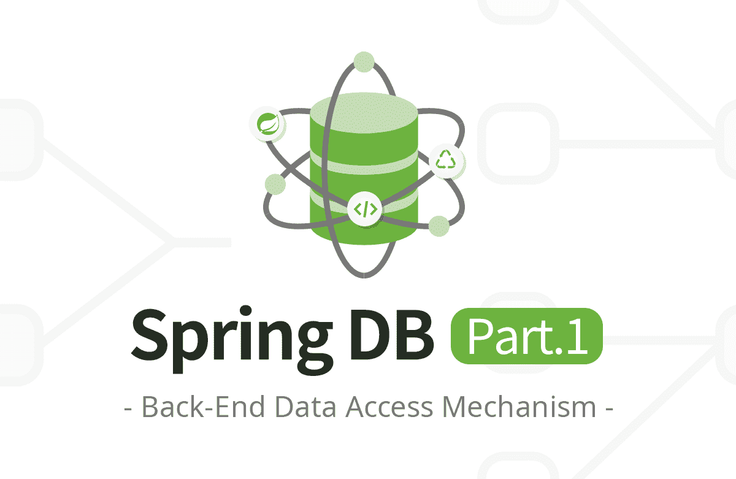Spring DB Part 1 - Core Principles of Data Access
You can understand and perfect the basics of DB data access technology required for backend development. You can understand the principles and structure of Spring DB access technology and grow into a more in-depth backend developer.

Kim Young-han's Practical Java - Advanced Part 2, I/O, Network, Reflection Open Schedule Confirmed
hello everyone
Kim Young-han's Practical Java - Advanced Part 2, I/O, Network, Reflection
The opening schedule has been confirmed to be between Monday, October 7th and Friday, October 11th .
Lecture time: 21 hours 35 minutes
Number of lectures: 100 lectures
Lecture PDF materials: Approximately 400 pages
[Course Introduction]
The goal is to completely master I/O, networking, reflection, and annotations from the basics to the level required for practical use.
And this lecture is particularly code and example-oriented .
We will use everything we have learned so far - from Java Beginner, Basic, Intermediate 1, 2, Advanced 1 - to Multi-threading - while creating various examples such as member management through files, chat, and web application servers.
So, through the Java roadmap, you can learn in depth how the Java content you have learned so far is actually utilized through example code.
[Full Table of Contents]
1. Character encoding
* Project environment configuration
* Computers and data
* Computers and Character Encoding1
* Computers and Character Encoding2
* Character set lookup
* Character encoding example 1
* Character encoding example 2
* organize
2. IO Basics 1
* Start Stream1
* Start Stream 2
* InputStream, OutputStream
* File I/O and Performance Optimization 1 - Write One by One
* File I/O and Performance Optimization 2 - Buffer Utilization
* File I/O and Performance Optimization 3 - Writing Buffered Streams
* File I/O and Performance Optimization 4 - Reading Buffered Streams
* File I/O and Performance Optimization 5 - Write at a time
* organize
3. IO Basics 2
* Handling Text 1 - Getting Started
* Handling characters 2 - Stream to characters
* Character Handling 3 - Reader, Writer
* Character Handling 4 - BufferedReader
* Other streams
* organize
4. IO Utilization
* Member Management Example 1 - Memory
* Member Management Example 2 - Save to file
* Member Management Example 3 - DataStream
* Member Management Example 4 - ObjectStream
* XML, JSON, database
* organize
5. File, Files
* File
* Files
* Show path
* Read text files with Files
* Optimized file copying
* organize
6. Network - Basic Theory
* Client and server
* Internet communication
* IP (Internet Protocol)
* TCP, UDP
* PORT
* DNS
7. Network - Program 1
* Network Program 1 - Example
* Network Program 1 - Analysis
* Network Program 2 - Example
* Network Program 2 - Analysis
* Network program 3
* Resource Management 1
* Resource Management 2
* Resource Management 3
* Resource Management 4
8. Network - Program 2
* Network Program 4 - Resource Management 1
* Network Program 5 - Resource Management 2
* Network Program 6 - Resource Management 3
* Network Program 6 - Resource Management 4
* Network exception 1 - Connection exception
* Network exception 2 - timeout
* Network exception 3 - Normal termination
* Network exception 4 - Forced shutdown
* Summary and Problems
9. Chat program
* Chat program - design
* Chat program - client
* Chat program - Server 1
* Chat program - Server 2
* Chat program - Server 3
* Chat program - Server 4
* organize
10. HTTP - Basic Theory
* HTTP Basic Theory
* HTTP method
11. Create an HTTP server
* HTTP Server 1 - Start
* HTTP Server 2 - Concurrent Requests
* HTTP Server 3 - Added features
* URL encoding
* HTTP Server 4 - Request, Response
* HTTP Server 5 - Command Pattern
* History of Web Application Servers
* organize
12. Reflection
* Why reflection is needed
* Classes and metadata
* Method lookup and dynamic invocation
* Field navigation and value change
* Reflection - Usage Examples
* Constructor search and object creation
* HTTP Server 6 - Reflection Servlet
* organize
13. Annotation
* Why annotations are needed
* Annotation definition
* Meta annotation
* Annotations and inheritance
* Using annotations - validator
* Java Basic Annotations
* organize
14. Using HTTP Server
* HTTP Server 7 - Annotation Servlet 1 - Start
* HTTP Server 8 - Annotation Servlet 2 - Dynamic Binding
* HTTP Server 9 - Annotation Servlet 3 - Performance Optimization
* HTTP server utilization - Member management service
* organize
thank you




